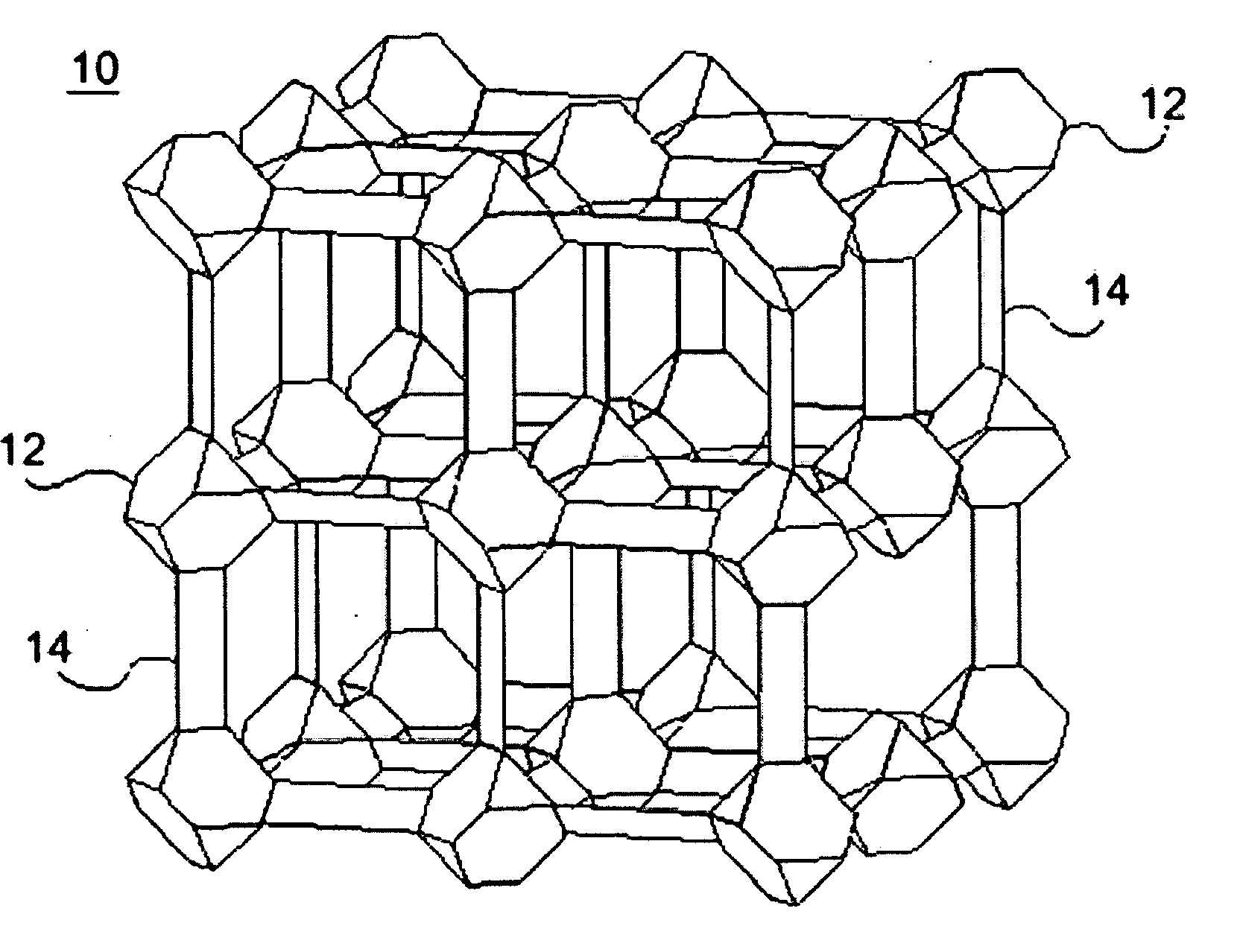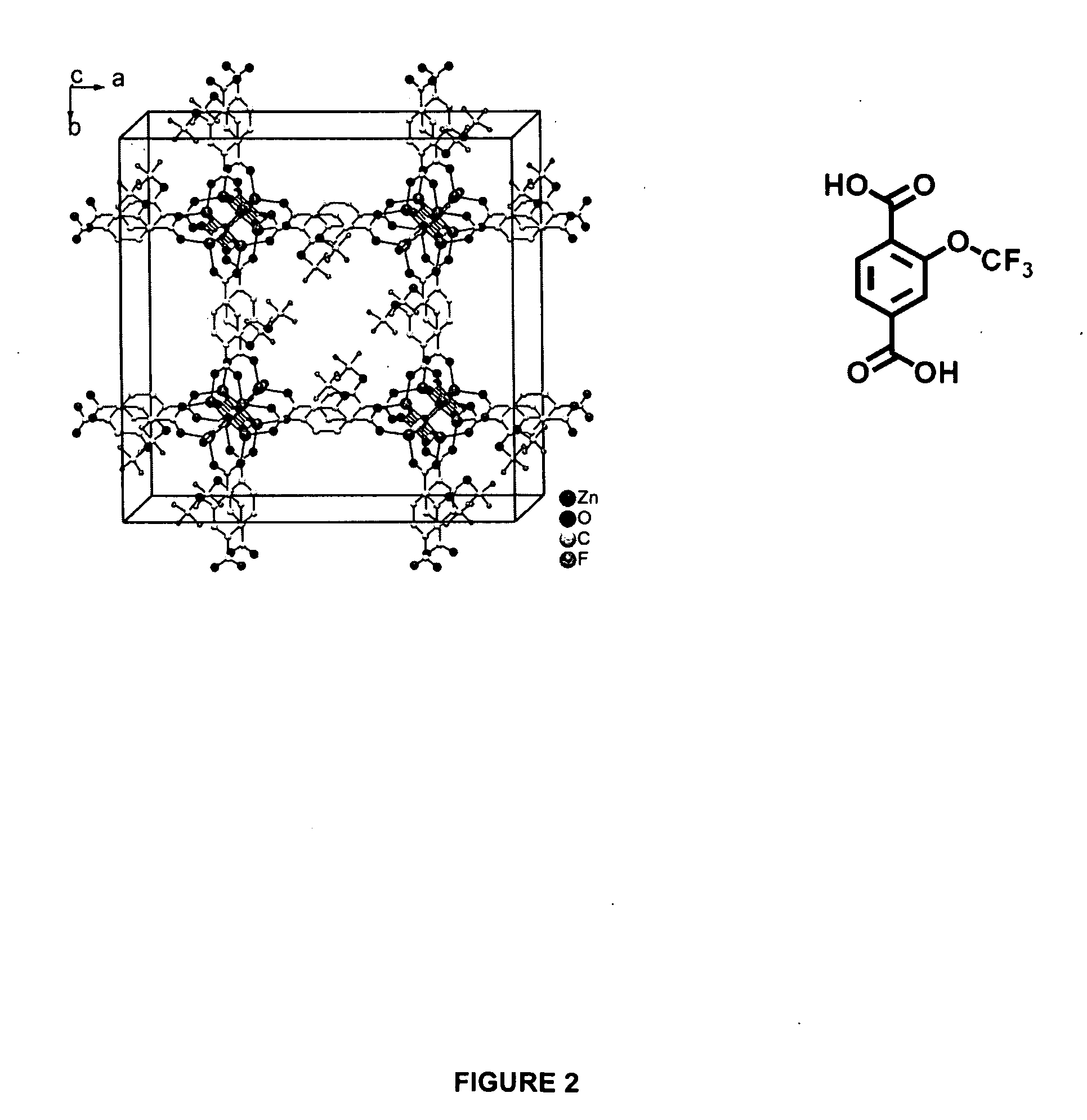Water repellent metal-organic frameworks, process for making and uses regarding same
a technology of metal organic frameworks and metal organic frameworks, applied in the field of water repellent metal organic frameworks, can solve the problems of decreased surface area, lack of stability, adverse effects of mof applications, etc., and achieve the effects of improving mof stability, reducing production costs, and increasing mof stability
- Summary
- Abstract
- Description
- Claims
- Application Information
AI Technical Summary
Benefits of technology
Problems solved by technology
Method used
Image
Examples
specific example 1
Solvothermal Synthesis of ZnMOF3
[0096]Zinc nitrate hexahydrate, Zn(NO3)2.6H2O, (0.15 g, 0.504 mmol) and 2-trifluoromethoxy terephthalic acid, (2-CF3O—BDCH2) (0.0946 g, 0.378 mmol), were dissolved in about 10 mL diethylformamide. The solution was then sealed in a Pyrex sample vial and heated at about 110° C. Transparent cubic crystals were collected after one week.
specific example 2
Microwave Assisted Solvothermal Synthesis of ZnMOF3
[0097]Zinc nitrate hexahydrate, Zn(NO3)2.6H2O, (0.15 g, 0.504 mmol) and 2-trifluoromethoxy terephthalic acid, (2-trifluoromethoxy-BDCH2) (0.0946 g, 0.378 mmol), were dissolved in about 10 mL diethylformamide. The solution was then sealed in a Pyrex sample vial and heated with a household microwave oven (800 W) for a reaction time of about 80 seconds. The crystals were then soaked in dichloromethane overnight. Next the crystals were dried by heating from room temperature to 170° C. over 5 hours in a clean nitrogen atmosphere, maintained at 170° C. for 3 hours, ramped to 200° C. over 30 minutes, held at 220° C. for 1.4 hours, then cooled to room temperature. The crystals were yellow in cubic shape, with size in a range of about 4 μm to about 7 μm with very few surface defects.
Specific Example 3
Conversion of ZnFOF8 to Non-Isoreticular Form
[0098]The MOF in Specific Example 2, above, was placed in a glass thimble. The thimble was placed ...
specific example 3
Microwave Assisted Solvothermal Synthesis of ZnMOF8
[0099]Zinc nitrate hexahydrate, Zn(NO3)2.6H2O, (0.1 g, 0.336 mmol) and 2,5-dimethylterephthalic acid (0.0490 g, 0.252 mmol), were dissolved in about 10 mL diethylformamide. The solution was then sealed in a Pyrex sample vial and heated with a household microwave oven (800 W) for a reaction time of about 30 seconds. The crystals were then soaked in dichloromethane overnight. Next the crystals were dried by heating from room temperature to 170° C. over 5 hours in a clean nitrogen atmosphere, maintained at 170° C. for 3 hours, ramped to 200° C. over 30 minutes, held at 220° C. for 1.4 hours, then cooled to room temperature. The resulting crystals have a cubic shape and a light yellow color, having a size in a range of about 1 μm to about 3 μm. FIG. 8 is a XPDP pattern showing the water stability of ZnMOF8 before and after exposure to water vapor for 2 hours. The XPDP shows that ZnMOF8 is water repellent.
PUM
| Property | Measurement | Unit |
|---|---|---|
| Time | aaaaa | aaaaa |
| Time | aaaaa | aaaaa |
| Time | aaaaa | aaaaa |
Abstract
Description
Claims
Application Information
 Login to View More
Login to View More - R&D
- Intellectual Property
- Life Sciences
- Materials
- Tech Scout
- Unparalleled Data Quality
- Higher Quality Content
- 60% Fewer Hallucinations
Browse by: Latest US Patents, China's latest patents, Technical Efficacy Thesaurus, Application Domain, Technology Topic, Popular Technical Reports.
© 2025 PatSnap. All rights reserved.Legal|Privacy policy|Modern Slavery Act Transparency Statement|Sitemap|About US| Contact US: help@patsnap.com



